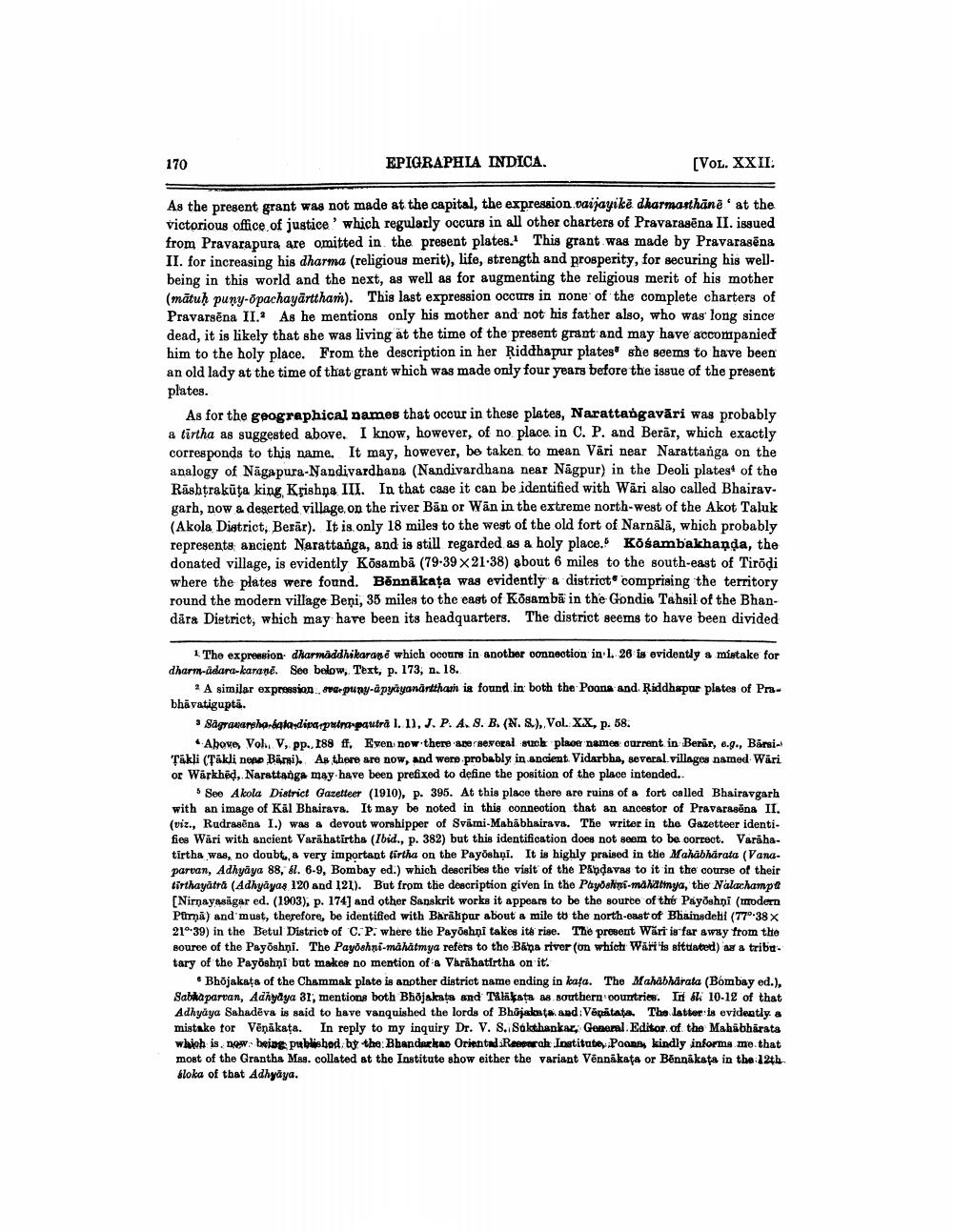________________
170
EPIGRAPHIA INDICA.
[VOL. XXII.
As the present grant was not made at the capital, the expression vaijayike dharmasthäne' at the victorious office of justice' which regularly occurs in all other charters of Pravarasëna II. issued from Pravarapura are omitted in the present plates. This grant was made by Pravarasēna II. for increasing his dharma (religious merit), life, strength and prosperity, for securing his wellbeing in this world and the next, as well as for augmenting the religious merit of his mother (mātuh puny-Opachayārttham). This last expression occurs in none of the complete charters of Pravarsēna II. As he mentions only his mother and not his father also, who was long since dead, it is likely that she was living at the time of the present grant and may have accompanied him to the holy place. From the description in her Riddhapur plates she seems to have been an old lady at the time of that grant which was made only four years before the issue of the present plates.
As for the geographical names that occur in these plates, Narattangavāri was probably a tirtha as suggested above. I know, however, of no place in C. P. and Berar, which exactly corresponds to this name. It may, however, be taken to mean Väri near Narattanga on the analogy of Nägapura-Nandivardhana (Nandivardhana near Nagpur) in the Deoli platest of the Rashtrakūta king Krishna III. In that case it can be identified with Wäri also called Bhairav. garh, now a deserted village, on the river Bān or Wän in the extreme north-west of the Akot Taluk (Akola District, Berār). It is only 18 miles to the west of the old fort of Narnālā, which probably represents ancient Narattanga, and is still regarded as a holy place. Kosambalhanda, the donated village, is evidently Kösambă (79-39 X 21:38) about 6 miles to the south-east of Tirodi where the plates were found. Bēnnākața was evidently a district comprising the territory round the modern village Beni, 38 miles to the east of Kosambā in the Gondia Tahsil of the Bhandāra Dietrict, which may have been its headquarters. The district seems to have been divided
1. The expression dharmāddhikarani which ocours in another connection in l. 26 is evidently a mistake for dharm-ådana-karane. See below, Text, p. 173, n. 18.
A similar expression mapuny-apyāyanarttham is found in both the Poona and Riddhapur plates of Pra. bhavatigupta.
Sagram phobala divarputnapauta I. 1), J. P. A.S.B. (N. S.), Vol. XX, p. 58.
Above, Vol. V, pp., 188 ff. Even now there are several suck place names ourrent in Berar, 6.g., Barsi Takli (Takli neno Bansi). As there are now, and were probably in ancient. Vidarbha, several villages named Wäri or Warkhēd, Narattanga may have been prefixed to define the position of the place intended..
5 See Akola District Gazetteer (1910), p. 395. At this place there are ruins of a fort called Bhairavgarh with an image of Kal Bhairava. It may be noted in this conneotion that an ancestor of Pravarasēna II. (viz., Rudrasena I.) was a devout worshipper of Svāmi-Mahābhairave. The writer in the Gazetteer identifies Wäri with ancient Varāhatirtha (Ibid., p. 382) but this identification does not seem to be correct. Varahatirtha was, no doubt, a very important tirtha on the Payoshội. It is highly praised in the Mahabharata (Vanaparvan, Adhyāya 88, 61. 6-9, Bombay ed.) which describes the visit of the Pandavas to it in the course of their tirthayātra (Adhyayas 120 and 121). But from the description given in the Payoshini-mahatmya, the Nalachampa [Nirnayasagar ed. (1903), p. 174] and other Sanskrit works it appears to be the source of the Payoshni (modern Pirmā) and must, therefore, be identified with Barakpur about a mile to the north-east of Bhainsdehi (77°38 X 21°39) in the Betul District of C. P. where the Payoshni takes its rise. The present Wari is far away from the source of the Payoshni. The Payoshni-mahatmya refers to the Bana river (on which Wari'is situated) as a tributary of the Payoshni bat makes no mention of a Varahatirtha on it.
• Bhöjakata of the Chammak plate is another district name ending in kata. The Mahabharata (Bombay ed.). Sabha parvan, Adhyaya 31, mentions both Bhojakata and Talakata as southern courrtries. In & 10-12 of that Adhyaya Sahadēva is said to have vanquished the lords of Bhūjakuts and Venátata. The latter is evidently, a mistake tor Vēņákata. In reply to my inquiry Dr. V. S. Sukthankar, General Editor of the Mahabharata whiob is. now. being published by the Bhandazkar Orientad.Resarch Institute Poona, kindly informs me that most of the Grantha Mss. collated at the Institute show either the variant Vēnnakata or Bēnnakata in the 12th Sloka of that Adhyāya.




